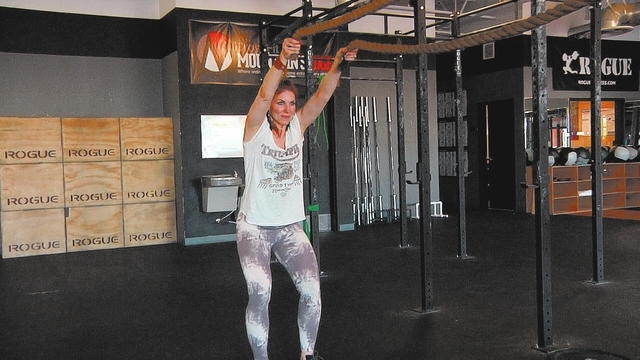String theory: Build strength with battle ropes






Every athlete has some weakness.
Whether it be speed, strength, flexibility, coordination or the ability to maintain proper movement mechanics throughout the course of exercise or sport.
I have weak ankles. It’s true. I am not good at field drills and lack at sports where fast feet are required. Does this mean I should avoid those activities altogether? Nope. It means I need to improve my ankle stability and strength. Performing rudimentary drills to focus on those issues is in my current training program.
I enjoy exposing athletes’ weaknesses, especially if they are advanced or very strong. Today’s exercises with the battle ropes are some I use to tax an athlete to expose and further improve some major weaknesses.
Battle ropes are showing up in gyms and garages across the Las Vegas Valley. If you choose to buy them, they can be found in most sporting goods stores. They are a good way of combining strength and endurance.
Most battle ropes are roughly 30 to 40 feet long. They typically have a 1½- to 2-inch diameter. They are designed to be awkward.
Most drills for battle ropes are arm and shoulder intensive but that doesn’t mean you can’t get creative and incorporate a leg movement, too.
Battle ropes need to have a strong anchor point. A heavy squat rack or piece of gym equipment works well. I have even used 100-pound dumbbells to anchor them. Give yourself plenty of room and be courteous of the gym space. Don’t anchor your rope on a machine or rack that another person is using. Don’t be in the way of people walking around the gym. Swinging ropes in the middle of a walkway makes for a dangerous game of double Dutch.
Most people get exhausted very fast on their first time swinging ropes. One reason is because they are not used to using their upper body in that fashion. The more practice, the longer they can swing the ropes.
As a trainer, I look for form. A person needs to be able to maintain some general but important body positions. The first thing I look for is core weakness manifest by a rounded spine during the battle rope drills. If the core is strong and active then the spine will be straight.
The shoulders need to be pulled back. They should not be shrugged, forward or internally rotated. If the back is strong, the shoulders will generally stay in a good position.
The hips need to be holding the majority of the body’s weight. If a person is standing straight up then the lumbar absorbs the natural sway of the body during movement. If the hips are hinged then the spine can stay straight without taking a beating. If the athlete is on the toes then the hips are underused and the knees are overloaded.
Watching these form requirements on a simple and awkward tasks such as swinging the battle ropes gives me a good idea of how the athlete performs in other areas.
Focusing on keeping the back straight, the hips engaged and the shoulders protected will force you to make other movements efficient and aid in preventing injury.
Since the battle ropes are an intense exercise, you need to use them as such. But, performing 20 minutes of battle rope slams unbroken may not be advised. When starting out, I recommend using a repetition constraint. This looks like the typical set and repetition breakup. For example, two sets of 10 repetitions will be enough for a first exposure to an exercise like the slam. Four sets of 16 repetitions would be a good first exposure to the seated battle rope throw.
Pay attention to the universal form positions. If you start to degrade, you have two options: Fix it and continue with the set or stop and rest. When fatigue really starts to set in, people are less aware of position and less able to correct themselves midset. At this point, it is advised to stop and rest.
If you feel conditioned and are able to keep form throughout your sets, progress your workout to a time constraint. Working 30 to 60 seconds for four to eight sets with 20 to 30 seconds of rest between sets may be just the thing you need to intensify your workout.
Chris Huth is a Las Vegas trainer. He can be reached at 702trainer@gmail.com. Consult your physician before beginning any exercise program.


















